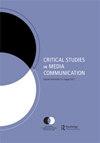“新冷战”中的白人男子气概:将《洛奇4》和《白夜》解读为多向记忆
IF 1.5
2区 文学
Q3 COMMUNICATION
引用次数: 0
摘要
对20世纪80年代电影的研究已经注意到一种“意识形态集合体”的趋势——多种相互矛盾的意识形态记录的存在。本文认为,通过迈克尔·罗斯伯格(2009)的《多向记忆:缅怀非殖民化时代的大屠杀》,80年代电影的“意识形态集大成”变得清晰而连贯。斯坦福大学出版社)多向记忆的概念。因此,本文将多向记忆的理论框架应用于两部“新冷战”电影的分析——西尔维斯特·史泰龙的《洛奇4》(1985)和泰勒·哈克福德的《白夜》(1985)。通过多向记忆的镜头阅读《洛奇4》,我们可以感知到“新冷战”、美国种族化逻辑和纳粹政权种族化图式之间的联系。在《白夜》中,对多向记忆的分析凸显了阿肯色州小石城与1968年民主党全国代表大会之间的联系,以及将国家暴行、种族主义和问责制等相关话语转移到苏联身上。文章的结论是,多向记忆为研究“新冷战”电影提供了一个生成性的理论框架,阐明了电影如何将美国冷战与种族逻辑联系起来,以确保白人男子气概的霸权。本文章由计算机程序翻译,如有差异,请以英文原文为准。
White masculinity in the “New Cold War”: reading Rocky IV and White Nights as multidirectional memories
ABSTRACT Studies of films of the 1980s have noted a tendency towards “ideological conglomeration”—the presence of multiple contradictory ideological registers. This article argues that 80s films’ “ideological conglomeration” is made legible and coherent through Michael Rothberg’s (2009, Multidirectional memory: Remembering the Holocaust in the age of decolonization. Stanford University Press) concept of multidirectional memory. It thus proceeds to apply a theoretical framework of multidirectional memory to the analysis of two “New Cold War” films—Sylvester Stallone’s Rocky IV (1985) and Taylor Hackford’s White Nights (1985). Reading Rocky IV through a lens of multidirectional memory allows us to perceive links between the “New Cold War,” U.S. racializing logics, and the racializing schemas of the Nazi regime. In White Nights an analytic of multidirectional memory foregrounds the connections between Little Rock, Arkansas, the 1968 Democratic National Convention, and the displacement of the associated discourses of state brutality, racism, and accountability onto the Soviet Union. The article concludes that multidirectional memory offers a generative theoretical framework for the study of the cinema of the “New Cold War” that illuminates how films link U.S. Cold War and racial logics to secure the hegemony of white masculinity.
求助全文
通过发布文献求助,成功后即可免费获取论文全文。
去求助
来源期刊

Critical Studies in Media Communication
COMMUNICATION-
CiteScore
2.10
自引率
0.00%
发文量
34
期刊介绍:
Critical Studies in Media Communication (CSMC) is a peer-reviewed publication of the National Communication Association. CSMC publishes original scholarship in mediated and mass communication from a cultural studies and/or critical perspective. It particularly welcomes submissions that enrich debates among various critical traditions, methodological and analytical approaches, and theoretical standpoints. CSMC takes an inclusive view of media and welcomes scholarship on topics such as • media audiences • representations • institutions • digital technologies • social media • gaming • professional practices and ethics • production studies • media history • political economy. CSMC publishes scholarship about media audiences, representations, institutions, technologies, and professional practices. It includes work in history, political economy, critical philosophy, race and feminist theorizing, rhetorical and media criticism, and literary theory. It takes an inclusive view of media, including newspapers, magazines and other forms of print, cable, radio, television, film, and new media technologies such as the Internet.
 求助内容:
求助内容: 应助结果提醒方式:
应助结果提醒方式:


